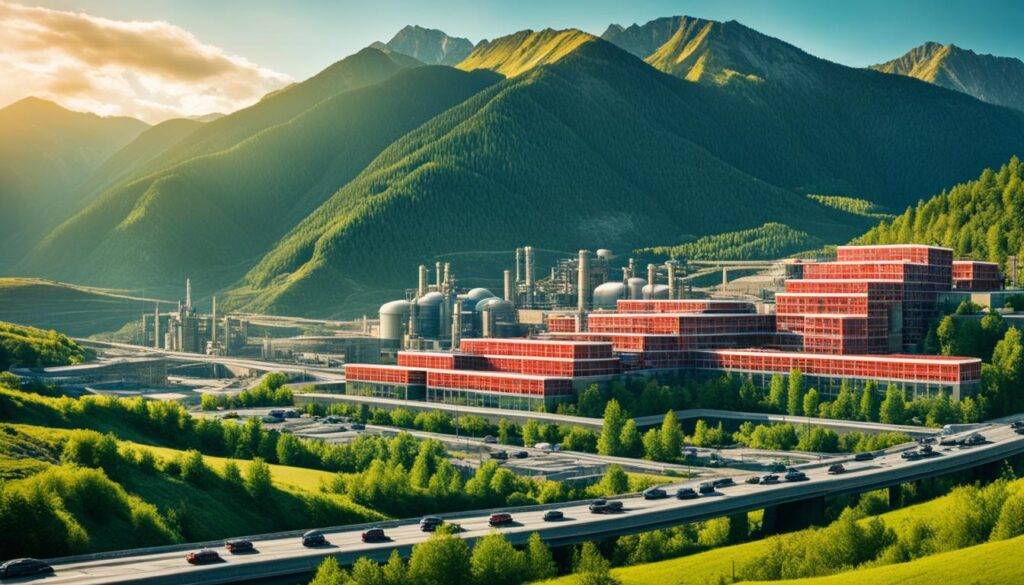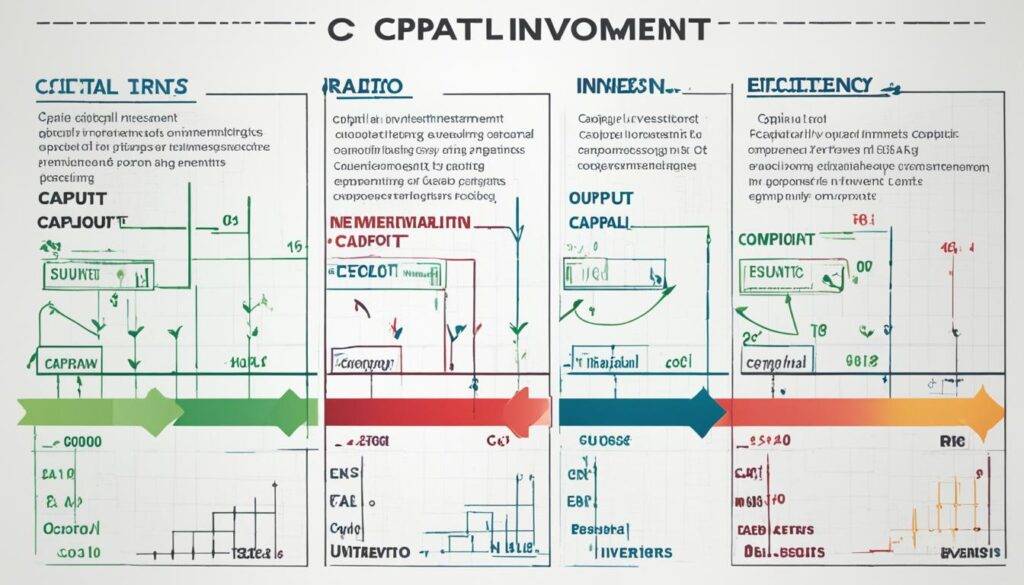When it comes to assessing investment efficiency and economic growth, one crucial metric that economists rely on is the incremental capital-output ratio. This ratio measures how much additional capital investment is needed to produce a unit increase in output or economic activity.
Investment plays a vital role in driving economic growth and development, but it is important to evaluate its efficiency. The incremental capital-output ratio provides valuable insights into the effectiveness of investment by indicating how much additional capital is required to generate a particular level of output.
By analyzing the incremental capital-output ratio, economists can gain a deeper understanding of the productivity and efficiency of investments. This ratio helps to determine how efficiently capital is being utilized within an economy and how well it translates into economic output.
Key Takeaways:
- The incremental capital-output ratio measures the additional capital investment needed to produce a unit increase in output or economic activity.
- It serves as a valuable tool for assessing investment efficiency and productivity.
- By analyzing this ratio, economists can evaluate how well capital is being utilized within an economy and its impact on economic growth.
- The incremental capital-output ratio plays a significant role in development economics and sustainable economic progress.
- Case studies and examples provide real-world applications of this ratio, highlighting its relevance and effectiveness.
The Basics of the Incremental Capital-Output Ratio
In economics, the incremental capital-output ratio (ICOR) is a critical measure used to assess the efficiency of capital investment and its contribution to economic growth. It shows the relationship between the amount of capital accumulated and the resulting increase in output or production.
To understand the ICOR, we need to look at how it is calculated. The formula for ICOR is:
ICOR = ΔK / ΔY
Where ΔK represents the change in capital accumulation and ΔY represents the change in output. The ICOR provides insights into the productivity of additional capital investments and helps policymakers and economists gauge the effectiveness of capital allocation.
Capital accumulation plays a vital role in driving economic growth. Increased capital investment leads to the expansion of productive capacity, job creation, and improved living standards. However, it is crucial to examine the efficiency of these investments to ensure that resources are allocated optimally and yield the desired economic outcomes.
With the ICOR, analysts can assess whether additional capital inputs result in proportionate or diminishing increases in output. A low ICOR indicates high productivity and efficient capital allocation, as a small increase in capital leads to a significant rise in output. Conversely, a high ICOR suggests diminishing returns and highlights the need for better resource management and investment strategies.
Let's explore the relationship between the ICOR and capital accumulation more deeply through the example below:
| Year | Capital Accumulation (ΔK) | Output Increase (ΔY) | ICOR = ΔK / ΔY |
|---|---|---|---|
| 2017 | 200,000 | 500,000 | 0.4 |
| 2018 | 250,000 | 550,000 | 0.45 |
| 2019 | 300,000 | 600,000 | 0.5 |
Table 1: Example illustrating the calculation of ICOR over three years.
In Table 1, we can observe that as capital accumulation increases, there is a gradual decrease in the ICOR. This indicates that the investment is becoming more efficient, with each dollar of additional capital generating higher output compared to previous years.

By understanding the basics of the incremental capital-output ratio and its relationship to capital accumulation, we can gain valuable insights into the efficiency of investment and its impact on economic growth. In the next section, we will explore how the ICOR is used to evaluate investment efficiency and conduct productivity analysis.
Evaluating Investment Efficiency through the Incremental Capital-Output Ratio
In the quest to measure investment efficiency and enhance productivity, the incremental capital-output ratio (ICOR) emerges as a valuable tool. This ratio provides insights into the effectiveness of capital investments and their impact on economic growth. By evaluating the ICOR, policymakers and analysts can make informed decisions to optimize resource allocation and drive sustainable development.
The Significance of the Incremental Capital-Output Ratio
The incremental capital-output ratio serves as a key indicator of investment efficiency, reflecting the amount of capital needed to generate a unit increase in output. A lower ICOR implies higher productivity and efficient resource allocation, as it indicates that a smaller investment is required to achieve an output expansion. On the other hand, a higher ICOR suggests lower investment efficiency and potential inefficiencies in capital allocation.
Through the ICOR, policymakers can assess the overall efficiency of investment projects, identify bottlenecks, and prioritize strategic areas for maximum impact. This analysis enables them to direct resources toward sectors that offer the greatest potential for productivity gains, ultimately fostering economic growth and development.
Conducting Productivity Analysis with the Incremental Capital-Output Ratio
Productivity analysis plays a crucial role in evaluating the performance of industries, sectors, and economies as a whole. By incorporating the incremental capital-output ratio into productivity assessments, analysts can gain deeper insights into the efficiency and effectiveness of investments.
Comparing the ICOR across different sectors allows for benchmarking and identifying areas with high or low investment efficiency. This analysis can further uncover productivity gaps and help formulate strategies to address them. By focusing efforts on sectors with lower ICOR values, policymakers can stimulate investment, enhance productivity, and create a positive multiplier effect on economic growth.
Evidence-Based Decision-Making: Case Studies and Examples
Real-world case studies and examples provide evidence of the incremental capital-output ratio's effectiveness in shaping investment decisions and driving economic growth. Let's take a look at a few noteworthy examples:
- In the manufacturing sector, Company X invested in modernizing its production facilities, resulting in a significant decrease in the ICOR. This strategic investment led to enhanced productivity, cost savings, and an overall improvement in the sector's performance.
- In the agricultural industry, Country Y implemented targeted policies to promote mechanization and infrastructure development. As a result, the ICOR decreased, indicating improved investment efficiency and increased agricultural output.
- In the renewable energy sector, the installation of advanced technologies and the optimization of resource allocation resulted in a lower ICOR. This outcome demonstrated the sector's commitment to sustainability while achieving positive economic and environmental outcomes.
These examples highlight how the incremental capital-output ratio serves as a practical tool for guiding investment decisions and driving economic growth across various sectors. By analyzing and benchmarking the ICOR, stakeholders can identify opportunities to enhance productivity, foster development, and create a more efficient and sustainable economy.
Impact of the Incremental Capital-Output Ratio on Economic Growth
In the field of development economics, the incremental capital-output ratio (ICOR) plays a crucial role in assessing the relationship between investment efficiency and economic growth. Understanding the impact of the ICOR on economic development is essential for policymakers and analysts alike.
The ICOR represents the amount of capital investment required to produce one unit of output. A lower ICOR indicates higher efficiency, as it suggests that less investment is needed to generate the same level of output. On the other hand, a higher ICOR suggests lower efficiency and potentially slower economic growth.
By monitoring and analyzing ICOR, economists can gain valuable insights into the productivity and efficiency of investment projects. This information helps policymakers make informed decisions about resource allocation and identify areas where efficiency improvements are needed.
Economic Growth and ICOR
Research has shown that a lower ICOR is associated with higher economic growth rates. When investment is allocated efficiently and productivity is enhanced, economies can achieve sustainable development and prosperity. Lower ICOR reflects an optimal allocation of resources, signaling that the economy is operating at an efficient level.
In contrast, a higher ICOR can indicate inefficiencies in investment projects, such as misallocation of resources or ineffective utilization of capital. This can lead to decreased productivity and hinder economic growth.
It is important to note that the impact of ICOR on economic growth may vary across different contexts and regions. Factors such as technological advancements, human capital development, and institutional frameworks can influence the relationship between ICOR and economic performance.
Table: Comparative Analysis of ICOR and Economic Growth Across Countries
| Country | ICOR | Economic Growth Rate (%) |
|---|---|---|
| Country A | 4.5 | 5.2 |
| Country B | 6.2 | 3.8 |
| Country C | 3.8 | 7.1 |
This table presents a comparative analysis of ICOR and economic growth rates across different countries. It highlights how variations in ICOR can be associated with divergent economic performance. Country C, with a lower ICOR of 3.8, demonstrates a higher economic growth rate of 7.1%, indicating greater investment efficiency compared to Country B, which has a higher ICOR of 6.2 and a lower growth rate of 3.8%.
Overall, the incremental capital-output ratio serves as a valuable indicator of investment efficiency and its impact on economic growth. By understanding the relationship between ICOR and economic performance, policymakers and economists can work towards fostering sustainable development and maximizing the potential of investments.
Case Studies and Examples of the Incremental Capital-Output Ratio
In this section, we will explore real-world case studies and examples that demonstrate the practical application and effectiveness of the incremental capital-output ratio in assessing investment efficiency and driving economic growth.
Case Study 1: Manufacturing Industry
In the manufacturing industry, Company A implemented a series of capital investments aimed at improving production processes and increasing output. By calculating the incremental capital-output ratio, the company was able to analyze the relationship between the additional capital invested and the resulting increase in output. This analysis helped Company A make informed decisions about future investments, ultimately improving their investment efficiency and promoting economic growth.
Case Study 2: Renewable Energy Sector
In the renewable energy sector, Country B invested heavily in solar power infrastructure to reduce its reliance on fossil fuels and promote sustainable energy sources. By using the incremental capital-output ratio, the government of Country B was able to evaluate the efficiency of each investment in terms of output generated. This analysis enabled them to allocate resources more effectively, prioritize projects with higher returns, and drive economic growth while advancing environmental sustainability.
Example: Construction Project
Consider a construction project where Company C decided to invest in advanced machinery and technology to improve productivity and meet increasing demand. By calculating the incremental capital-output ratio, Company C could assess the efficiency of these investments by comparing the additional capital injected with the resulting increase in construction output. This evaluation allowed them to optimize their investment decisions, improve investment efficiency, and contribute to overall economic growth in the construction industry.
These case studies and examples highlight the importance of the incremental capital-output ratio in decision-making processes, investment evaluation, and achieving sustainable economic growth. By analyzing the relationship between capital investments and output, businesses and governments can make data-driven choices, improve investment efficiency, and foster economic prosperity.
Conclusion
Throughout this article, we have explored the concept of the incremental capital-output ratio and its significance in assessing investment efficiency and driving economic growth.
By measuring the incremental capital-output ratio, economists can evaluate the amount of capital required to generate a unit of output. This ratio serves as a key indicator of investment efficiency, highlighting the effectiveness of capital allocation in achieving economic development.
In the field of development economics, understanding and improving the incremental capital-output ratio is crucial for sustainable economic progress. By optimizing investment decisions and promoting efficient resource allocation, countries can enhance their productivity, stimulate economic growth, and ultimately improve the well-being of their citizens.
As highlighted in our case studies and examples, the incremental capital-output ratio provides valuable insights into real-world scenarios. It not only allows us to evaluate the performance of different economies but also assists policymakers in formulating effective strategies to enhance investment efficiency and foster long-term economic development.
FAQ
What is the incremental capital-output ratio?
The incremental capital-output ratio is a measure used to assess the efficiency of investment. It represents the amount of capital required to generate a unit increase in output or GDP. In other words, it shows how much investment is needed to achieve a certain level of economic growth.
How is the incremental capital-output ratio calculated?
The incremental capital-output ratio is calculated by dividing the change in capital stock by the change in output or GDP. Mathematically, it can be expressed as ICOR = ΔK/ΔY, where ΔK is the change in capital stock and ΔY is the change in output.
What does a high incremental capital-output ratio indicate?
A high incremental capital-output ratio suggests that a larger amount of investment is needed to generate a unit increase in output. This indicates lower investment efficiency, as more resources are required to achieve the same level of economic growth.
How does the incremental capital-output ratio affect economic growth?
The incremental capital-output ratio plays a significant role in economic growth. A lower ratio indicates higher investment efficiency, which can lead to faster economic growth. Conversely, a higher ratio suggests lower investment efficiency, which can hamper economic development.
What is the importance of the incremental capital-output ratio in development economics?
In development economics, the incremental capital-output ratio helps policymakers and economists evaluate the effectiveness of investment in promoting economic progress. By assessing investment efficiency through this ratio, policymakers can make informed decisions to allocate resources and foster sustainable economic development.
Can you provide some examples or case studies related to the incremental capital-output ratio?
Certainly! One example of the incremental capital-output ratio in action is the comparison between two countries. Country A has an ICOR of 4, while Country B has an ICOR of 8. This implies that Country A achieves the same level of economic growth with half the investment compared to Country B, highlighting its higher investment efficiency.
In conclusion, what is the significance of the incremental capital-output ratio?
The incremental capital-output ratio is a crucial measure in assessing investment efficiency and its impact on economic growth. It enables policymakers and economists to analyze the effectiveness of capital accumulation and make informed decisions to support sustainable development.



